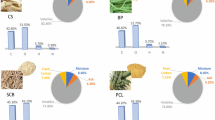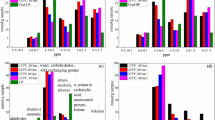Abstract
In this study, hydrothermal and acid pre-treatments were applied to improve the raw material properties of the bean pod. To evaluate the biomass as a fuel, it is superior to have low moisture content, high volatile matter, and carbon content. As acid concentration changed in acid washing and impregnation, different trends were observed in these contents. The optimum working concentration to meet all these properties was chosen as 1 M acid. In hydrothermal pre-treatment, as the temperature increased with constant reaction time, the moisture content of the biomass decreased while the amount of volatile matter was raised. According to the SEM, FT-IR, TGA, and preliminary and elemental analysis characterization results, the samples with high C and low O content after evaluating in hydrothermal pre-treatment at 190 °C for 20 min and hydrothermal pre-treatment at 150 °C for 20 min, washing with 1 M H3PO4, and impregnating with 1 M H3PO4 were subjected to pyrolysis process. When the tar yields obtained from impregnating with 1 M H3PO4 and washing with 1 M H3PO4 samples were compared, it was seen that the washing process gave a higher (19.56%) tar yield. In the pyrolysis experiments, the highest tar yield (22.18%) was achieved by using the hydrothermal pre-treatment at 190 °C for 20 min sample with a volatile matter content of 71.59%. Total volatile matter yields of pyrolysis were listed as (hydrothermal pre-treatment at 190 °C for 20 min) > (washing with 1 M H3PO4) > (impregnating with 1 M H3PO4) > (hydrothermal pre-treatment at 150 °C for 20 min). As a result, it can be concluded that the processes performed as hydrothermal method or acidic pre-treatment compared to raw biomass have an important role in obtaining the desired product distribution and properties in biofuel production.












Similar content being viewed by others
References
Ghysels S, Ronsse F, Dickinson D, Prins W (2019) Production and characterization of slow pyrolysis biochar from lignin-rich digested stillage from lignocellulosic ethanol production. Biomass Bioenergy 122:349–360. https://doi.org/10.1016/j.biombioe.2019.01.040
Burhenne L, Messmera J, Aicher T, Laborie MP (2013) The effect of the biomass components lignin, cellulose and hemicellulose on TGA and fixed bed pyrolysis. J Anal Appl Pyrolysis 101:177–184. https://doi.org/10.1016/j.jaap.2013.01.012
Shen DK, Gu S (2009) The mechanism for thermal decomposition of cellulose and its main products. Bioresour Technol 100:6496–6504. https://doi.org/10.1016/j.biortech.2009.06.095
Shen DK, Gu S, Bridgwater AV (2010) Study on the pyrolytic behaviour of xylan-based hemicellulose using TG–FTIR and Py–GC–FTIR. J Anal Appl Pyrolysis 87:199–206. https://doi.org/10.1016/j.jaap.2009.12.001
Kawamoto H, Nakamura T, Saka S (2008) Pyrolytic cleavage mechanisms of lignin-ether linkages: a study on p-substituted dimers and trimers. Holzforschung 62:50–56. https://doi.org/10.1515/HF.2008.007
Bridgwater AV (2012) Review of fast pyrolysis of biomass and product upgrading. Biomass Bioenergy 38:68–94. https://doi.org/10.1016/j.biombioe.2011.01.048
Akhtar J, Amin NAS (2011) A review on process conditions for optimum bio-oil yield in hydrothermal liquefaction of biomass. Renew Sust Energ Rev 15:1615–1624. https://doi.org/10.1016/j.rser.2010.11.054
Toor SS, Rosendahl L, Rudolf A (2011) Hydrothermal liquefaction of biomass: a review of subcritical water technologies. Energy 36:2328–2342. https://doi.org/10.1016/j.energy.2011.03.013
Kobayashi T, Kohn B, Holmes L, Faulkner R, Davis M, Maciel GE (2011) Molecular-level consequences of biomass pretreatment by dilute sulfuric acid at various temperatures. Energy Fuel 25:1790–1797. https://doi.org/10.1021/ef1017219
Carlson TR, Cheng YT, Jae J, Huber GW (2011) Production of green aromatics and olefins by catalytic fast pyrolysis of wood sawdust. Energy Environ Sci 1(4):145–161. https://doi.org/10.1039/C0EE00341G
Thangalazhy-Gopakumar S, Adhikari S, Gupta RB (2012) Catalytic pyrolysis of biomass over H+ZSM-5 under hydrogen pressure. Energy Fuel 26:5300–5306. https://doi.org/10.1021/ef3008213
Zheng Y, Shi J, Tu M, Cheng YS (2017) Principles and development of lignocellulosic biomass pretreatment for biofuels. Advances in Bioenergy, Vol. 2-1st Edition, Elsevier.
Kumagai S, Matsuno R, Grause G, Kameda T, Yoshioko T (2015) Enhancement of bio-oil production via pyrolysis of wood biomass by pretreatment with H2SO4. Bioresour Technol 178:76–82. https://doi.org/10.1016/j.biortech.2014.09.146
Hassan EM, Steele PH, Ingram L (2009) Characterization of fast pyrolysis bio-oils produced from pretreated pine wood. Appl Biochem 154:3–13. https://doi.org/10.1007/s12010-008-8445-3
Wang H, Srinivasan R, Yu F, Steele P, Li Q, Mitchell B, Samala A (2012) Effect of acid, steam explosion, and size reduction pretreatments on bio-oil production from sweetgum, switchgrass, and corn stover. Appl Biochem 167:285–297. https://doi.org/10.1007/s12010-012-9678-8
Pu Y, Hu F, Huang F, Davison BH, Ragauskas AJ (2013) Assessing the molecular structure basis for biomass recalcitrance during dilute acid and hydrothermal pretreatments. Biotechnol Biofuels 6(15):1–13. https://doi.org/10.1186/1754-6834-6-15
Vegas R, Kabel M, Schols HA, Alonso JL, Parajo JC (2008) Hydrothermal processing of rice husks: effects of severity on product distribution. J Chem Technol Biotechnol 83:965–972. https://doi.org/10.1002/jctb.1896
Ruiz H, Rodriguez-Jasso RM, Fernandes BD, Vicente AA, Teixeira JA (2013) Hydrothermal processing, as an alternative for upgrading agriculture residues and marine biomass according to the biorefinery concept: a review. Renew Sust Energ Rev 21:35–51. https://doi.org/10.1016/j.rser.2012.11.069
Hao N, Bezerra TL, Wu Q, Ben H, Sun Q, Adhikari S, Ragauskas AJ (2017) Effect of autohydrolysis pretreatment on biomass structure and the resulting bio-oil from a pyrolysis process. Fuel 206:494–503. https://doi.org/10.1016/j.fuel.2017.06.013
Ragauskas AJ, Williams CK, Davison BH, Britovsek G, Cairney J, Eckert CA (2006) The path forward for biofuels and biomaterials. Science 311:484–489. https://doi.org/10.1126/science.1114736
Stefanidis SD, Kalogiannis KG, Iliopoulou EF, Michailof CM, Pilavachi PA, Lappas AA (2014) A study of lignocellulosic biomass pyrolysis via the pyrolysis of cellulose, hemicellulose and lignin. J Anal Appl Pyrolysis 105:143–150. https://doi.org/10.1016/j.jaap.2013.10.013
TMMOB, Ziraat Mühendisleri odası, 2018 yılı Fasulye (Kuru) Raporu, http://zmo.org.tr/genel/bizden_detay.php?kod=30014&tipi=38&sube=0" http://zmo.org.tr/genel/bizden_detay.php?kod=30014&tipi=38&sube=0, Access date: 25.04.2020.
ASTM Standard test method for bulk density of densified particulate biomass fuels, In ASTM Annual Book of Ame. Soc. for Testing and Materials Standard, Easton, M.D., USA, E 873-82, 1983.
ASTM Standard test method for ash in wood, In ASTM Annual Book of Ame. Soc. for Testing and Materials Standard, Easton, M.D., USA, D-1102-84, 1983.
ASTM Standard test method for volatile matter in analysis sample refuse derived fuel-3, In ASTM Annual Book of Ame. Soc. for Testing and Materials Standard, Easton, M.D., USA, E-897-82, 1983.
Harker JH, Backhurst JR (1981) Fuel and energy 120, 1st edn. Academic Press Inc., London
Uzun BB, Yaman E (2014) Thermogravimetric characteristics and kinetics of scrap tyre and Juglans regia shell co-pyrolysis. Waste Manag Res 32(10):961–970. https://doi.org/10.1177/0734242X14539722
Fermanelli CS, Córdoba A, Pierella LB, Saux C (2020) Pyrolysis and copyrolysis of three lignocellulosic biomass residues from the agro-food industry: a comparative study. Waste Manag 102(2020):362–370. https://doi.org/10.1016/j.wasman.2019.10.057
Rosas JM, Bedia J, Rodríguez-Mirasol J, Cordero T (2009) HEMP-derived activated carbon fibers by chemical activation with phosphoric acid. Fuel 88(1):19–26. https://doi.org/10.1016/J.FUEL.2008.08.004
Labruquere S, Pailler R, Naslain R, Desbat B (1998) Oxidation inhibition of carbon fibre preforms and C/C composites by H3PO4. J Eur Ceram Soc 18(13):1953–1960. https://doi.org/10.1016/S0955-2219(98)00135-6
Nowakowski DJ, Woodbridge CR, Jones JM (2008) Phosphorus catalysis in the pyrolysis behaviour of biomass. J Anal Appl Pyrolysis 83(2):197–204. https://doi.org/10.1016/j.jaap.2008.08.003
Guo F, Peng K, Liang S, Jia X, Jiang X, Qian L (2019) Evaluation of the catalytic performance of different activated biochar catalysts for removal of tar from biomass pyrolysis. Fuel 258:116204. https://doi.org/10.1016/j.fuel.2019.116204
Bi H, Wang C, Lin Q, Jiang X, Jiang C, Bao L (2020) Pyrolysis characteristics, artificial neural network modeling and environmental impact of coal gangue and biomass by TG-FTIR. Sci Total Environ 751:142293. https://doi.org/10.1016/j.scitotenv.2020.142293
Molina-Sabio M, Rodrıguez-Reinoso F (2004) Role of chemical activation in the development of carbon porosity. Colloid Surf A 241(1-3):15–25. https://doi.org/10.1016/j.colsurfa.2004.04.007
Caillat S, Vakkilainen E (2013) Large-scale biomass combustion plants: an overview. Biomass Combustion Science, Technology and Engineering. Woodhead Publishing, 189-224.
Ozbay N, Yargic AS, Sahin RZY, Yaman E (2019) Valorization of banana peel waste via in-situ catalytic pyrolysis using Al-Modified SBA-15. Renew Energy 140:633–646. https://doi.org/10.1016/j.renene.2019.03.071
Wang Z, Cao J, Wang J (2009) Pyrolytic characteristics of pine wood in a slowly heating and gas sweeping fixed-bed reactor. J Anal Appl Pyrolysis 84:179–184. https://doi.org/10.1016/j.jaap.2009.02.001
Çulcuoglu E, Ünay E, Karaosmanoglu F, Angin D, Şensöz S (2005) Characterization of the bio-oil of rapeseed cake. Energy Sources 27(13):1217–1223. https://doi.org/10.1080/00908310490479592
Özçimen D, Karaosmanoğlu F (2004) Production and characterization of bio-oil and biochar from rapeseed cake. Renew Energy 29(5):779–787. https://doi.org/10.1016/j.renene.2003.09.006
Kumar R, Strezov V, Weldekidan H, He J, Singh S, Kan T, Dastjerdi B (2020) Lignocellulose biomass pyrolysis for bio-oil production: a review of biomass pre-treatment methods for production of drop-in fuels. Renew Sust Energ Rev 123:109763. https://doi.org/10.1016/j.rser.2020.109763
Cao B, Wang S, Hu Y, Abomohra AE-F, Qian L, He Z, Wang Q, Uzoejinwa BB, Esakkimuthu S (2019) Effect of washing with diluted acids on Enteromorpha clathrata pyrolysis products: towards enhanced bio-oil from seaweeds. Renew Energy 138:29–38. https://doi.org/10.1016/j.renene.2019.01.084
Mohammed IY, Abakr YA, Kazi FK, Yusuf S (2017) Effects of pretreatments of napier grass with deionized water, sulfuric acid and sodium hydroxide on pyrolysis oil characteristics. Waste Biomass Valori 8:755–773. https://doi.org/10.1007/s12649-016-9594-1
Wang X, Leng S, Bai J, Zhou H, Zhong X, Zhuang G, Wang J (2015) Role of pretreatment with acid and base on the distribution of the products obtained via lignocellulosic biomass pyrolysis. RSC Adv 5:24984–24989. https://doi.org/10.1039/C4RA15426F
Hoekman SK, Broch A, Robbins C, Zielinska B, Felix L (2013) Hydrothermal carbonization (HTC) of selected woody and herbaceous biomass feedstocks. Biomass Convers Biorefin 3:113–126. https://doi.org/10.1007/s13399-012-0066-y
Hoekman SK, Broch A, Robbins C (2011) Hydrothermal carbonization (HTC) of lignocellulosic biomass. Energy Fuel 25:1802–1810. https://doi.org/10.1021/ef101745n
Funding
This study was financially supported by the Bilecik Şeyh Edebali University Scientific Research Council with the project number 2016-02.BŞEÜ.03-01.
Author information
Authors and Affiliations
Corresponding author
Additional information
Publisher’s Note
Springer Nature remains neutral with regard to jurisdictional claims in published maps and institutional affiliations.
Supplementary information
ESM 1
(DOCX 26 kb)
Rights and permissions
About this article
Cite this article
Özbay, N., Yaman, E., Yargıç, A.Ş. et al. Hydrothermal vs. dilute acid pre-treatments: comparison of the biomass properties, distribution of pyrolysis products, and bio-oil characteristics. Biomass Conv. Bioref. 13, 739–753 (2023). https://doi.org/10.1007/s13399-020-01203-0
Received:
Revised:
Accepted:
Published:
Issue Date:
DOI: https://doi.org/10.1007/s13399-020-01203-0




